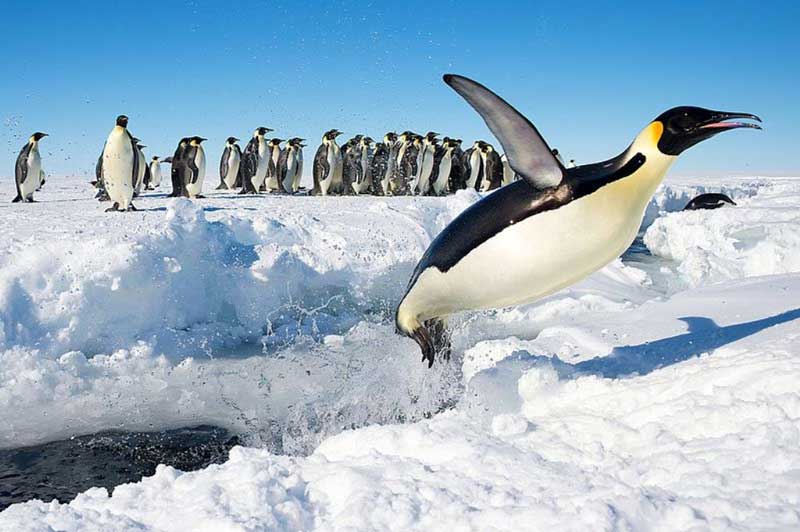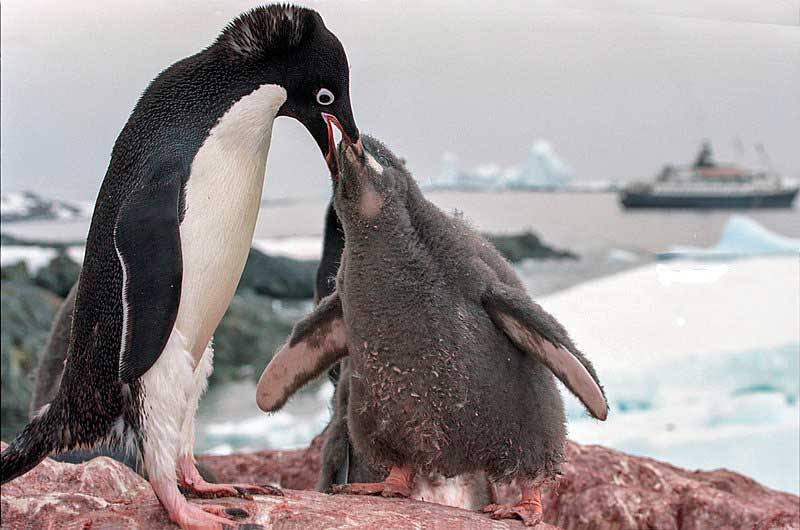
The stocky, short-legged penguins, the flightless aquatic birds covered with striking black and white coat, live exclusively in the Southern Hemisphere, except only one species, the Galapagos penguins that are found north of the Equator. Living in colonies with large population, and surviving in harsh cold conditions, they are often seen as the emblem of Antarctica. However, only two species, the Emperor and Adelie, make the Antarctic continent their true home,while the others breed on the northern tip of the Antarctic Peninsula, where conditions are less harsh.
It is considered by many that the name penguin originates from the Welsh pen gwyn, which means white head, or from the Latin penguins, referring to the fat or blubber of the bird. The name penguin was first given to another type of bird, the great auk. Later, when the European explorers discovered actual penguins in the hemisphere, they found their resemblance with the great auk of the Northern Hemisphere and named them after that. However, despite their resemblance, the penguins are not closely related to the great auk.

Most of the penguins are black on the back and white below, somewhat look-alike gentlemen in white trousers and black coats. Often they have black lines across the upper breast or white spots on the head. Some species have yellow brow tufts and orange and yellow on the head, neck, and breast in the emperor and king penguins. Although penguins belonging to different species have similar body form and structure, their sizes vary greatly in size. While the little blue penguin, also known as the fairy penguin, stands around 13 to 16 inches (33 to 40 cm) tall and weighs about 1 kg, the adult emperor penguins are about 3 feet 7 inches (3`60 m) tall and weigh 35 kg.

The penguins are flightless seabirds, and nature has provided them with a thick layer of blubber or tallow and tightly packed oily feathers, ideally suited to confront the challenge of harsh cold temperature. They do not have the wings to fly, but their wings, which have evolved to become stiff flippers, webbed feet, and body shape, are perfect for good swimming. They can swim about 24 km (15 miles) an hour and often leap out of the water as they swim. In fact, the penguins spend most of their time in the ocean and hunt squid, krill, and crabs. They are good divers too. However, the small penguins dive to catch their prey near the surface, and their dives normally last only a minute or two. But the large penguins, especially the emperor penguins, are the world’s deepest-diving bird and can dive to about 1800 feet (550 m) deep while searching for food. While not in the water, the penguins with their upright stance tend to waddle, hop, or even run ridiculously, with their bodies angled forward. The penguins in the polar region often travel long distances by sliding across the ice on their bellies while pushing their bodies forward with their feet.

Except for the yellowed-eyed and the Fiordland species, penguins for the most part breed in large colonies, which may vary in size from 100 pairs of gentoo penguins to several hundred thousand in the case of the king, macaroni, and chinstrap penguins. For the breeding season, they form monogamous pairs. Penguins come ashore to their eggs and raise their chicks. Usually, the females lay two eggs in a clutch, except the emperor and the king penguins, who lay only one. Both the male and the female penguins share the incubation duties, except for the emperor penguins, where the males take the responsibility alone.

Unfortunately, about two-thirds of penguin species are enlisted as one of the most endangered seabirds. Apart from the loss of habitat, infectious diseases spread by the tourists, getting accidentally captured by the fishing nets, especially by commercial fishing in the Sothern Ocean, and hunting and poaching for their oil and egg, the biggest threat to the penguin population is global warming, resulting in the melted sea ice in the Polar Regions.